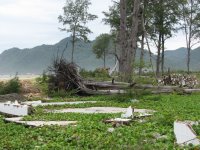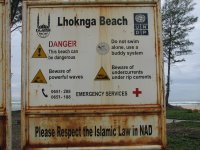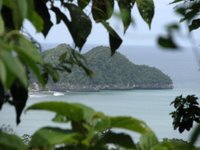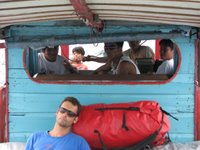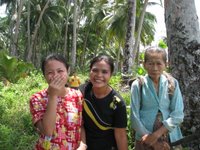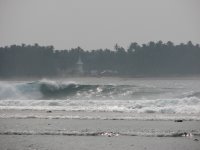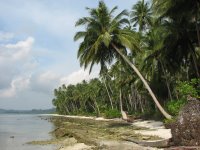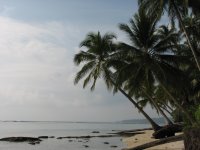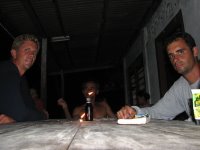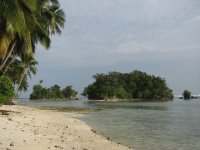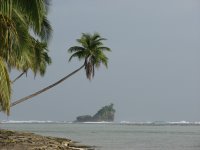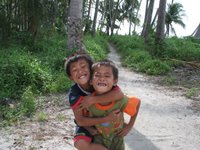Banda Aceh
 "On December 26, 2004, an earthquake struck 150 km off the coast of Aceh. It was the most powerful the world has seen in a generation. Forty-five minutes later the tsunami wave hit Aceh and within minutes it swept clean an 800 km coastal strip of Aceh -- equivalent to the coastline from San Francisco to San Diego. Some 130,000 people were killed and 37,000 remain missing."
"On December 26, 2004, an earthquake struck 150 km off the coast of Aceh. It was the most powerful the world has seen in a generation. Forty-five minutes later the tsunami wave hit Aceh and within minutes it swept clean an 800 km coastal strip of Aceh -- equivalent to the coastline from San Francisco to San Diego. Some 130,000 people were killed and 37,000 remain missing."*Double click on photos to enlarge, click on "back" to return to main page.
 Situated closer to Sri Lanka, India, and Miramar than the Indonesian capital of Jakarta, Banda Aceh points like a finger towards the Bay of Bengal. Centuries of influence from south Asia and the Middle East has resulted in a unique culture and a strict Muslim Society.
Situated closer to Sri Lanka, India, and Miramar than the Indonesian capital of Jakarta, Banda Aceh points like a finger towards the Bay of Bengal. Centuries of influence from south Asia and the Middle East has resulted in a unique culture and a strict Muslim Society.GAM (Free Aceh Movement) has battled the Indonesian government for over 3 decades in a guerilla war. Established in 1976, GAM's main goal was the creation of an Autonomous Muslim state. Guerilla warfare, atrocities committed by the Indonesian Military, a complete press blackout, and a foreign travel ban continued up until the great tsunami of December 2004. After the almost complete destruction of the Aceh coast and the massive loss of life, political differences and skirmishes must have seemed trivial. An accord was signed giving Aceh designation as a semi- autonomous region and peace for now. Earlier this year, the Indonesian government granted Banda Aceh the right to impose Sahria Law, which is a strict interpretation of the Koran. Social laws are enforced by the "morality police", and public floggings occur for offences such as drinking alcohol or young men and women associating in public.
To Go or Not to Go
Our decision to go to Banda Aceh was something that we considered very carefully. What did we have to fear? Strict Muslim law, possible anti-western sentiment, being hungry during Ramadan, GAM Rebels, and the post tsunami situation were all on that list. And for the surf; would wind conditions be favorable? (we had conflicting reports). When we asked our friend Shane what he thought he replied, "The people in Aceh were desperate before the tsunami, just think how desperate they are now. They’re going to see two bules (westerners) carrying heaps of luggage with dollar signs on their foreheads. Go to Aceh and you'll wake up dead mate!"
Not very encouraging, but Shane had never been to Aceh, it was his fear doing the talking.
The other argument went something like this; "do you really want to go to the aftermath of a natural disaster? Do you think the people are really going to want to see you there?"
Well, first of all, it had been almost 2 years since the Tsunami and basic infrastructure had been built, the dead had been buried. And while no, I didn't want to see pain and suffering, I felt it was an important and unique opportunity to experience first hand. One must not insulate himself from the cruel realities of our world. Secondly, in my opinion, they did want to see us. They desperately needed our tourist dollars, and the return of tourists brings hope of a return to normalcy.
And of course for us, was the question of surf. A huge swell was on its way and we couldn't afford to miss it. If we went to Bali, we were guaranteed waves but also crowds. We could head to West Java, but it was a long haul and the winds were rumored to be poor. Banda Aceh on the other hand was only an hour flight from Medan costing a measly $30. If the winds were right, we were guaranteed to score perfect waves to ourselves. Besides, the main wave zone was only 30minutes from the airport. If it turned out to be hell on earth, we could be on the next flight out of there.
Than night in our hotel in Medan I was beyond spent and full of stress. Since we left Kalapa Island it had been at least 4 days of brutal Sumatran travel (2 days on Tiduk Island, an all day boat ride to Nias, half a day bemo ride to Gunung Sitoli, overnight ferry to Sibolga, all day overland drive to Medan). I tossed and turned all night debating our mission to Aceh. Shane's words kept repeating over and over in my head; "You'll wake up dead mate!!"
 You Don't Know Until You Go
You Don't Know Until You GoThe one hour flight from Medan to Banda Aceh took us over north along a vast mountain range covered in what appeared to be virgin tropical forest. It reminded me of how wild a place Sumatra is, and made me happy to know that such places still exist. We landed in the tiny airport without a problem sorted out a bemo ride to Lok Gna. Our bemo driver was a kind man who spoke good English. He asked us what NGO we were with, and when we explained that we were surfers and not relief workers he seemed surprised but smiled. We asked him about Ramadan, and he explained how it worked, and then offered to stop at the market so we could buy some fruit. It was ok to eat inside the car he explained, and he wasn't bothered that we were eating in front of him. As we bipassed the urban area of Banda Aceh, he pointed out how far the Tsunami waters had reached. We were shocked to learn it reached a good 8 miles inland. Soon we approached the western side of the peninsula and a torrential downpour began. We pulled up to a stormy ocean and Tsunami destruction zone. The new structures looked as if they were built on top of city destroyed by an atomic bomb. Our hearts dropped with the rain and the onshore winds. Perhaps it was a mistake to come to this god forsaken place. We pulled up to a small caddie shack that stood where the old golf course once was. The owner had a picture of himself on the wall with President Clinton, a post tsunami relief visit. The man saw the disappointment on our faces and took it for fear. He assured us that everything was ok here and that we were safe.
We arrived at Mami Diana's and were met by Mami and her youngest daughter Nina. Mami has been hosting surfers for over 20 years. That night the family invited us into their house for a traditional Acehnese meal after the break of Ramadan. That night the Tsunami stories began to unfold.
Tsunami Stories
Written by Adam Towle
Written by Adam Towle
Mami Diana, appears to be that. A cute, aged, slightkly round mami with big eyes and lighter Acehnese features. 20 years of catering to surfers has given her a good command of English. It was a beautiful morning, and mami went to Banda Aceh early to do a bunch of shopping for the upcoming week. While at the market, the earthquake hit. Mami’s been through them before but this was bad. She could barely walk out of the market! Fortunately the building didn’t collapse, nor did the people panic. It lasted 3 to 4 minutes which seemed very long. After it was over she was very worried about her family and hired a taxi to immediately take her back to Lhoknga. Traffic was bad and it took about 20 minutes to reach the rise overlooking the flat coastal plain and Lhoknga. The taxi stopped. Something was wrong. Mami said that it looked like a dragon or giant snake was knocking down houses, and the 300 foot radio tower crumpled and twisted like a toy. She couldn’t understand. Then some panicked people drove by, fleeing for the hills. What she had seen was the first 2 waves. The 3rd was on its way. The taxi drove for the high ground just as the wave washed 6km inland and met the other wave from Banda Aceh in the middle. Mami watched Lhoknga get engulfed by what looked like 200 feet of water. She collapsed she said, worried for her family, and helpless to the situation. She would not be reunited with her daughters for 3 days. She says those three days were horror, and she can’t remember much except, a feeling of helplessness and despair.
NONI
Noni is the 23 year old daughter. She’s very cute with a big smile, dark, electric eyes, a nervous laugh, and a sort of goofy manner. She spoke with animation, and seemed to cover her great sorrow with laughter and jokes about what happened. Noni woke up at 3 am because her cat Taft was biting her toes. This was strange she said. So she got a fish out of the fridge. But Taft wasn’t hungry; the big tabby just stared at her and meowed. Noni decided to fry it for her, but Taft still wasn’t hungry. She thought this was strange, but went back to bed. That was the last time she Taft again. She woke up at 8am to the earthquake shaking the house "like a lid on a pot of boiling water" and ran outside. She could barely stand up, but it soon subsided. She went back inside to start picking up the mess of everything knocked down. It was then that she heard three consecutive booms that sounded like bombs going off. She had heard bombs before from the war, and was wondering what the rebels were bombing this time. She went outside to investigate. When she looked towards the ocean she saw what looked like "a snow covered island" out at sea. It was glistening and sparkling and she couldn’t figure out what it was. Then she heard a roar like a jet airplane and realized it was a wave coming towards them. She screamed for her neighbor and ran inside to get the box that had Mami’s jewelry. She then got on her moped and told her neighbor to hurry up. Her neighbor said wait I need to lock the house! Noni laughed. "You know, she lost her whole house, but still had the key!"
Take a close look at the Causarina trees in the
foreground. The tsunami went over the top.
The cement factory in the background is
where Mami's son was working when he
lost his life.
She said the wave was taller than the trees on the beach, which to me appeared to be about 80 feet high. She said she drove as fast as she could to the hills and ran for her life. She spent the next three days looking for her family in the mud, flotsam and bodies in Lhoknga. At some point she cut her leg. A few weeks later, she developed tetanus, and then lock jaw. She laughed and imitated herself trying to talk with clenched teeth. "You know Doctor Mitchell from California?" she asked innocently. I replied that I did not.well Indonesian doctor no help me, they too busy saving people worse off, but this nice American doctor, give me shots, and tell me I be okay. He come see me every day and after a few days I could open my mouth and laugh again! Nina Nina sat nursing her 3 month old baby Latifah. She’s a beautiful girl with a rounder face and Malay eyes. Her tone was serious, her eyes probing deep into mine to make sure I understood her story. Nina was awake when the earthquake hit, and decided to go check and see if her friends who lived by the beach were okay. She got on her brothers bike (a sort of cheap hybrid mountain bike) and pedaled down to the beach. Before she got far she heard 3 booms and looked towards the ocean. "It looked so tall that I though it might be clouds touching the ocean, but I could see the bubbles and foam glistening in the sun. Then I heard the roar like a thousand helicopters" Nina said she had seen a movie once (end of days?) with a tsunami in it. She says this saved her life because she knew right away what it was, and quickly turned and pedaled like mad for the hills. When she passed her house, she saw her sisters were already gone and kept going, screaming the whole way. Her neighbor, an older man came to the door in his pajamas and asked sleepily "what is it" not stopping to explain, she yelled TSUNAMI IS COMING! The last words she heard him speak were "who is tsunami?" before she got far she saw her sister Nona getting into the Australian expat named David’s car. She ditched the bike and got in. The bike survived by the way, and they showed me a photograph of Noni, with her goofy smile and head scarf on sitting on the huffy that outran the tsunami.
NONA
Nona looks distinctly Arabic, very pretty, tall, and quiet. She never said a word about the tsunami, and often left the room while the girls talked.
YOYO
Yoyo is Nina’s husband. He’s 26 years old, and Javanese. He’s skinny, and looks younger than his age, but carries himself in an old wizened manner. He seemed to be overly polite to us while explaining his story. He works for the Red Cross and came to Lhoknga to help after the tsunami. He showed up 5 days after, and said he had no idea how bad it was. They told us hundreds of people were dead, so we didn’t expect to find thousands he said. Yoyo spent 30 days, working everyday, picking up bodies to be placed in a mass grave by bulldozers in Banda Aceh. He said he and his co worker picked up 2-3 HUNDRED bodies a day, in the tropical heat for the entire month (do the math). I couldn’t believe I was looking at a sane man. He said the biggest problem were dogs eating the bodies, the tropical rot (bodies came apart when they picked them up) heavily bloated corpses are hard to lift, and because of the stench and constant vomiting, he couldn’t eat much. I didn’t really know what to say when he told us this. "You know the problem now?" he said. When I look at people, I can’t help but picture what they look like dead...”
Bathroom tiles are all that remain of a
house destroyed.
JUDE
Jude (pronounced Judy) is a surfer. I knew this not just because he was repairing a surfboard in the yard behind Mami Diana’s. But because of his slow, deliberate purposeful manner. He was shirtless (strange for Muslims) and although skinny, quite strong.
Jude got up early that day and went and checked the surf. It was a beautiful day, the wind was offshore, but the waves were almost flat. He saw one local kid in the water, waving for him to join him, but like any jaded surfer who surfs epic waves most of his life, he decided to go back to bed and wait for the tide to switch. That was the last time he saw his friend. The earthquake woke him and sent him running outside. He went back in to clean up, when he heard the three booms that sounded like bombs coming from the beach. He went back outside where he saw a giant wall of whitewater way offshore. Did you know what it was? I asked. The way the foam was bouncing and the way it rumbled, I knew it was a wave he said. How big was it? I queried. Jude sanded his repair and seemed to ponder the question (surfers are notoriously conservative in wave height estimates) I don’t know, maybe eighty feet he said looking me in the eye. Jude said he grabbed his motor bike and got his father to jump on as the wave neared shore. He jammed on the gas and bolted for the hills. What did you see when you looked back? I asked. "Look back?" he answered with scorn in his eyes. “I never looked back man! I didn’t want to panic! Everyone in their cars were panicking and running into each other! I didn’t want to panic. I just looked for a clear line for the motorcycle and drove as fat as I could!" of course he did, I thought. Jude is a surfer. He didn’t panic, but while everything was a maelstrom around him, he picked a line, and went for it. He survived. Do you ever worry about a tsunami coming when you are out surfing? I asked. Jude smiled and seemed to laugh inwardly while reflecting on the question. "Man, if a tsunami comes while I am surfing, I have nothing to worry about."
Jude got up early that day and went and checked the surf. It was a beautiful day, the wind was offshore, but the waves were almost flat. He saw one local kid in the water, waving for him to join him, but like any jaded surfer who surfs epic waves most of his life, he decided to go back to bed and wait for the tide to switch. That was the last time he saw his friend. The earthquake woke him and sent him running outside. He went back in to clean up, when he heard the three booms that sounded like bombs coming from the beach. He went back outside where he saw a giant wall of whitewater way offshore. Did you know what it was? I asked. The way the foam was bouncing and the way it rumbled, I knew it was a wave he said. How big was it? I queried. Jude sanded his repair and seemed to ponder the question (surfers are notoriously conservative in wave height estimates) I don’t know, maybe eighty feet he said looking me in the eye. Jude said he grabbed his motor bike and got his father to jump on as the wave neared shore. He jammed on the gas and bolted for the hills. What did you see when you looked back? I asked. "Look back?" he answered with scorn in his eyes. “I never looked back man! I didn’t want to panic! Everyone in their cars were panicking and running into each other! I didn’t want to panic. I just looked for a clear line for the motorcycle and drove as fat as I could!" of course he did, I thought. Jude is a surfer. He didn’t panic, but while everything was a maelstrom around him, he picked a line, and went for it. He survived. Do you ever worry about a tsunami coming when you are out surfing? I asked. Jude smiled and seemed to laugh inwardly while reflecting on the question. "Man, if a tsunami comes while I am surfing, I have nothing to worry about."
DAVID
David the Australian seemed skeptical of us at first and greeted us coolly. He had lived in Lhoknga for 16 years and was married to an Acehnese woman. He had 2 young boys playing on the beach with him. In his early 40s, David seemed, healthy, but had a bitter looking stare. We asked him if he was here for the tsunami, and he related his version. David had just finished reading the book Krakatoa (the Javanese volcano which blew up in 1890 and created a 120 foot tsunami, and was heard in Great Britain). The earthquake was so strong that morning that he and his family had to lay down under the mango tree outside his house. He though for sure they were at the epicenter so he didn’t think of the tsunami. After hearing the 3 booms that followed, he was more concerned about a volcanic eruption. (1 big active volcanoe is near Banda Aceh). So he loaded up his car and prepared to evacuate. Then the first precursor wave came up the river by his house and he realized what was happening. In a panic they took off, picking up Nona and Nina and some others for a total of 9 people in his car! At one point someone blocked his way and he didn’t think they would make it. He only looked in his rear view mirror once. He said the wave was 18 meters (60 feet!) and the last thing he saw behind them was a giant yellow foam ball with running "stick figures" being swallowed up. David and his family spent 2 months in a refugee camp with, no water, no bathrooms, and only the clothes on their backs. He said he offered interviews to CNN for a hundred bucks, to try and make some money to go back to Australia, but they refused(Bastards). Finally he made it out. His house is rebuilt now.
"Please respect Islamic Law"
We read about a young couple
who were caught drinking alcohol
together on the beach.
Both were publicly flogged.
After David told us his story he suggested that we go out for surf before the wind turned fowl. We were a little early for the season, but the winds would sometimes switch offshore after a storm and that was the case this morning. We ran back and grabbed our boards, and although it was cloudy, we wore our rashguards in accordance with Sharia Islamic law. We had to paddle across the river, and as we waded in the shallows I imagined dead bodies coming to the surface or floating by (which was entirely possible with all the people still unaccounted for). We were on it, and although it was a little doubled up and not exactly clean, it was doing a good impersonation of Kirra, just like they say. It was such a trip surfing and thinking about the tsunami, looking back towards the land and its destruction, imagining a giant wave approaching. The wave was sucking out along a shallow reef/point like set up with a sandy beach on the inside. I got a super sucker throater that just got hollower as I went down the line. After 30 minutes the winds switched onshore and it was over, our one and only session there.
Car crushed like a tin can.
 Heading Deeper Again
Heading Deeper Again
The next day we decided to try our luck on the southern coast and rented a utility vehicle from a young man who sometimes worked for Mami. We threw our boardbags in the back, and foolishly failed to give the truck a thorough look over.
Our goal was to make it to the next major town which was a good 60 miles to the south. As we passed the cement factory we got our first look at this magnificent coastline. As we dropped down into the coastal plane the road turned from paved to a bumpy dirt track, plenty of holes and makeshift speed bumps. We passed village after destroyed village, heaps of temporary houses already built and reconstruction going on everywhere.
 Heading Deeper Again
Heading Deeper AgainThe next day we decided to try our luck on the southern coast and rented a utility vehicle from a young man who sometimes worked for Mami. We threw our boardbags in the back, and foolishly failed to give the truck a thorough look over.
Our goal was to make it to the next major town which was a good 60 miles to the south. As we passed the cement factory we got our first look at this magnificent coastline. As we dropped down into the coastal plane the road turned from paved to a bumpy dirt track, plenty of holes and makeshift speed bumps. We passed village after destroyed village, heaps of temporary houses already built and reconstruction going on everywhere.

We started to head into the mountains and the road returned to tarmac, the elevation left this stretch of road untouched from the tsunami. Triple canopy rainforest appearing to have never been logged extended as far as the eye could see.
The car began to make a weird noise when we turned, so we decided to pull over and check it out. "Shit!" The engine was overheating; steam and water were shooting out of a hole in the reservoir.
Angry monkey
Boiling over, I used my sarong to take off the cap and we poured in our drinking water. A troupe of agro monkeys was in the forest above us, heckling us for cramping their style. The engine temp dropped back to normal and we were off again into the coastal mountains.
One of many offshore options.
On a stretch high above the coast, as in Big Sur, we spotted a pair of islands right off the coast. The south island had a crazy looking left, and the north island also had a wave of its own. We dropped back down to the coastal plain and a stretch of the road that ran between tall cliffs and the beach. The road was affected by the high tide and was flooded to a depth of about 3 feet. As we crossed the section I kept it in second gear as water began entering the car through the floorboards and door jams. Right as we were about to make it back to dry road we stalled out. I got out and looked down
the beach where I saw a stretch of coconut palms sticking out of the sand like toothpicks, their tops ripped off by the tsunami. We were able to get the truck started and we climbed back into the mountains.
Sticks in the sand, all that's left.

Eventually we reached our destination of Lamno, which was a much bigger town than we had anticipated. This town had been devastated by the tsunami; most of the structures that we saw were recently donated and built by one of several NGOs working in the area. Being surfers, we went straight to the river mouth to check the surf. Reaching the end of the road where the bridge had been destroyed, we found the surf spot to be an uninviting dirty river mouth. It was late in the afternoon so we decided to go and look for accommodation.
We came to find out that the only place to stay was located somewhere near the market, and after driving through the narrow market street, squeezing between venders (three times), we found it. Adam went inside and came out with a frown. Adam reported that the place looked dodgy, he got a bad vibe and there was no room available for two hours. It was the only place to stay and we debated heading back. We drove all around town looking for other options, but eventually returned to the hotel which had a "room" available.

The place and our room was repulsive. I've stayed in some real hellholes all around the world and this place takes the cake (more on that later). It was time to surf, so we threw our stuff in our dankey cubicle and got our boards out. There was a painting of the local coastline on the wall of the place and a man who worked there pointed out a supposed surf spot and suggested we go there.

It was getting late and our directions were sketchy at best, but we decided to give it a go. After 15 km to the south we pulled off the main road onto a dirt track bordered by flooded canals. We crosed two super dodgy makeshift bridges, and then some locals directed us to continue left. The road deteriorated, turning fowl and muddy but we pressed on....it turned downright sketchy and I barged 4wd style, wheels spinning in the mud but keeping our momentum......BOOM! We hit a deep pothole, bounce 2 feet up....almost slow to a stop....regain traction and speed.....BOOM!! We high-center and finally reach a solid stretch. We park and check our vista of the beach; big swell with beach break closeouts. It was time to retreat and getting the truck turned around took a 12 point turn, literally.
We charge back through the mud section with better skills this time and soon reach the tarmac again. I'm keen to surf (I have nightmares about this, trying to surf before dark and everything is trying to prevent it) so I race back to town like Gunter the road warrior. When we reach town it is sore (sunset) and everyone and their brother's cousin is on their motor scooter, heading to the beach for the sunset. I drove like a mad Indo (but skilled one) utilizing my horn and passing people left and right. By the time we reach the river mouth, I'm delirious from the days driving and stress. The waves are shit and EVERYONE is staring at us like we are circus freaks.

We jump back in the truck and turn down another dirt road in search of a supposed surf spot. The road ends and we get out and climb to the top of a hill. I'll never forget standing on that hill with Adam, looking at large sets breaking in the horizon, knowing that somewhere on the coast were incredible waves going unridden, yet out of our reach.
But this time we had gone too far, tried too hard to get off the beaten track, and we had hoaxed ourselves. The roads were practically nonexistent, our truck was about to break down on us, and most importantly we were trying to surf in ground zero of the worlds greatest natural disaster for god's sake!
End of the Road
 We didn't even need to talk about it, we both new what the other guy was thinking: it was time to cut our losses and retreat. Adam suggested that we drive back to Lhokgna right there and then, but I convinced him it was a bad idea (I had the habit of always pointing out the worst case scenario, shit that might hit the fan. This earned me the title of "Doomsday"). This stretch of coast was a semi-lawless wild west. Driving at night with a crippled car on half flooded, tsunami ravaged road was a sure way to "wake up dead".
We didn't even need to talk about it, we both new what the other guy was thinking: it was time to cut our losses and retreat. Adam suggested that we drive back to Lhokgna right there and then, but I convinced him it was a bad idea (I had the habit of always pointing out the worst case scenario, shit that might hit the fan. This earned me the title of "Doomsday"). This stretch of coast was a semi-lawless wild west. Driving at night with a crippled car on half flooded, tsunami ravaged road was a sure way to "wake up dead".
Surviving the Night
Back at the losemen I headed to the Mandi for a shower. I noticed an employee was pumping water out of a gutter and in to a bucket to wash his clothes with. It struck me as odd, but I figured there was a shortage of fresh water. In the Mandi (water basin used for bucket shower) I swore that the water smelled a little fowl, but I figured the smell was coming from the toilet next door. The water looked clean enough so I went ahead and bathed.
After bathing we headed out to eat. Being that it was Ramadan, many people celebrate the break of the daily fast by going out to eat. We headed to a popular looking spot but basically were ignored. So we left and headed to a dive back in the market are that happened to still be open. The brought us cold rice, veggies and the dodgiest bowl of flesh I ever did see. We couldn't tell what kind of "meat" it was, maybe cow tongue or tripe, but it looked god awful. Needless to say we stuck to the rice and veggies and returned to the losemen.
Before sleeping I went to use the toilet and saw something that tops it all. A man was pumping gutter water into the water basin of the mandi. Not suburban California gutter water with a little lawn fertilizer or oil residue from the street. Imagine a 3rd world market where blood and fish guts drip down from the meat section, where drunken men and half naked children relieve themselves in the back alley, then it rains and it all washes into the gutter. This, my friends, is what I had bathed in.
"Adam, I probably shouldn't tell you this, but I figure you need to suffer along with me."
After explaining what I saw, Adam replied, "He's probably pumping water from the mandi into the gutter."
"No, go check it out."
Adam returned with a look of disgust.
That night was probably the worst sleep of my life. The ceiling fan sounded like a chopper, the guys in the room next door (our "room" was separated from the others by a partition that didn't reach the ceiling) smoked, talked, and played video games all night. The mosque across the street blared prayers over the loudspeaker all night, and we marinated in gutter water.
At sunrise we awoke and were on the road in 5 minutes flat. Our goal was to be on a flight out of Aceh that afternoon. On the ride back the truck continued to sputter as if it was running out of gas. And it ended up overheating twice. There were so many photos that I wanted to capture, such as the crippled mosque that had somehow survived, as if by the will of Allah. But we couldn't risk stopping. We had to get the truck back before it broke down and the owner swindled us into paying for the repairs (we came to the conclusion that this was his plan, there was no way that he didn't know about the leak in the radiator).
Luckily we made it back to Mami Diana's and asked Nonnie to take us to the airport. We bought a ticket straight to Bali. After 5 weeks of brutal travel through Sumatra, we were ready for good food, whiskey, and the right to associate with women in public. Not to mention the legendary surf!



